During the first 60 years of the mountain’s climbing history, a climb up the mountain’s slopes was a singular feat, and through this period numerous climbs sought to showcase Mount McKinley as a scientific laboratory. Thus scientists, as well as adventurers, made their mark in learning about North America’s highest peak and the conditions that prevail there.
Introduction
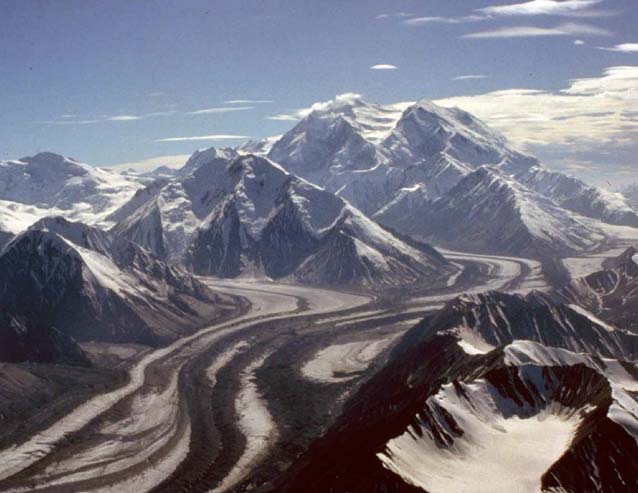
NPS Photo
Explorers and adventurers – with varying degrees of success – have been attempting to climb North America’s highest mountain for more than a century. In recent years, the slopes of Mount McKinley have witnessed a small army of invaders each spring as more than a thousand climbers make the valiant attempt to climb the 20,320-foot summit of the mountain’s South Peak.
During the first 60 years of the mountain’s climbing history, by contrast, a climb up the mountain’s slopes was a far more singular feat, and through this period numerous climbs sought to showcase Mount McKinley as a scientific laboratory. Thus scientists, as well as adventurers, made their mark in learning about North America’s highest peak and the conditions that prevail there.
During the nineteenth century, the area around Mount McKinley beckoned to the adventurous, and after 1880, both miners and U.S. Geological Survey expeditions reached ever closer to the mountain massif. In 1903, a group led by Fairbanks Judge James Wickersham made the first summit attempt; they were followed, in short order, by similar parties who aimed for the summit in 1906, 1910, and again in 1912. All failed.
Success was finally attained on the afternoon of June 7, 1913, when Harry Karstens, Hudson Stuck, Walter Harper, and Robert Tatum reached the top (Figure 2). Upon summiting the peak, Stuck, who combined scientific curiosity with a love of adventure, set up an “instrument tent” and proceeded to take measurements with a thermometer, a mercurial barometer, a boiling-point hypsometer, and a prismatic compass. Indeed, he devoted an entire chapter in his book, The Ascent of Denali, to his various attempts to determine the mountain’s height (Stuck 1914).
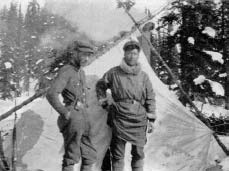
Hudson Stuck, The Ascent of Denali (1914).
No new attempts were made on the mountain for almost 20 years; in part a function of Mount McKinley’s extreme isolation, which made a summit attempt a major logistical challenge even after the completion of the Alaska Railroad in the early 1920s. In the spring of 1932, two expeditions got underway, one of which had science as its primary goal, specifically cosmic ray research. This field of inquiry had been launched in 1911 by Austrian scientist Victor F. Hess.
It became widely recognized that various sub-atomic, high-energy particles (Hess’ “cosmic radiation”) were gamma rays that bombarded the earth from space, and that cosmic ray intensity increased in high latitudes and high elevations. For that reason, the most likely points for measuring cosmic rays were believed to be in Alaska, Hawaii, New Zealand, Australia, Peru and Mexico (Beiser and Beiser 1962).
By January 1932, a brilliant electrical engineer from Bell Telephone Laboratories, Allen Carpé, had won a grant to pursue cosmic ray research, and he planned to carry out many of his measurements “at high elevations on Denali.” Carpé, an accomplished mountaineer, and four other colleagues planned a research camp high on the mountain’s slopes.
Rangers at Mt. McKinley National Park agreed to support the expedition by hauling 800 pounds of supplies from McKinley Park Station to the research base camp (Beiser and Beiser 1962, Brown 1991, Pearson 1962). In late April, bush pilot Joe Crosson made two flights that landed Carpé, colleague Theodore Koven, and additional equipment on the upper slopes of the Muldrow Glacier. By May 3, Carpé and Koven had established a camp at 11,000 feet and began their measurements. Several days later, however, tragedy struck.
Carpé fell into a huge crevasse. Koven, who was nearby, was unsuccessful in his attempt to retrieve Carpé. Severely injured, Koven stumbled toward camp but soon collapsed. Both men died and Carpé’s body, entombed in the crevasse, was never found (Figure 3)(Pearson 1962, SMR April-May 1932).
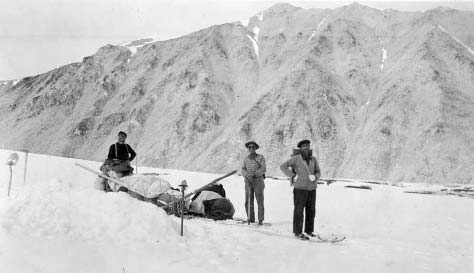
Grant Pearson Album, DENA 3065, Denali National Park Museum Collection
Four years after the Carpé and Koven expedition, a scientific crew from National Geographic Magazine took to the air on a two-day photographic reconnaissance of the mountain. Bradford Washburn shot a series of photos in an open-air compartment. The plane’s door had been removed, and Washburn sat on an old gas can wearing an oxygen mask, heavy mittens, and a cold-weather flying suit. Washburn was captivated by the experience, and the magazine brought him back in 1937 and 1938 to make additional aerial photos (Figure 4).
In 1947 another expedition, of which Bradford Washburn was a key member, had cosmic ray research as a “major scientific goal”(Sfraga 2004) (Figure 5). The genesis of that expedition, however, was not science but Hollywood; it was a movie project called The White Tower, based on a 1945 adventure novel by James Ramsey Ullman.
An RKO Pictures executive, Paul Hollister, called Washburn and pitched the idea of an expedition in order to obtain movie footage. Washburn, who was the head of the New England Museum of Natural History, told Hollister that Mount McKinley would best suit his needs and that he wanted to include science as part of the filming project (Sfraga 2004, Ullman 1945). So the call went to a number of top U.S. scientists “to suggest how many ways [the] expedition might make a real scientific contribution.”
Before long Dr. Marcel Schein, a University of Chicago physicist specializing in cosmic ray research, stepped forward and expressed an interest in the project (Sfraga 2004). Both Washburn and Schein hoped to establish a high-altitude scientific camp, at 18,180-foot Denali Pass (between North Peak and South Peak), where “high altitude survey work and other projects … could be carried out from a reasonably warm and comfortable base.”
Schein wanted a large research hut that would house a system of 300-pound telescopes, high-voltage bat-teries, photographic recorders, heaters, and an ionization chamber, all in support of cosmic ray research. The Army Air Force agreed to furnish air support (Sfraga 2004).
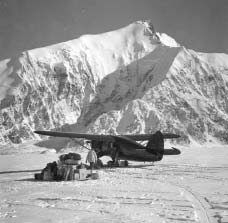
Operation White Tower Collection, Denali National Park Museum Collection
The expedition, dubbed “Operation White Tower,” was organized in Anchorage in mid-March 1947, and the initial base camp (at McGonagall Pass near Muldrow Glacier) was established on March 30 (Figure 6). By May 20, Brad Washburn and a climbing colleague had established the beginnings of a new camp at the 16,400-foot level, near Denali Pass. That evening, however, a “wild blizzard” began, and the “Great Storm” that followed howled for nine days and destroyed some of the expedition’s most valuable equipment.
Washburn and the other expedition members outlasted the storm. The Army Air Force airdropped the research hut and the replacement equipment, and scientist Hugo Victoreen conducted cosmic ray experiments at Denali Pass from June 17 through June 27. The data collected there was judged to be of great research value; such data had previously been “attainable only in short-duration plane flights”, and Washburn later wrote a report noting that Denali Pass “appears to be the most practical point for the erection and operation of the highest cosmic ray station on the mountain” (Drury 1950).
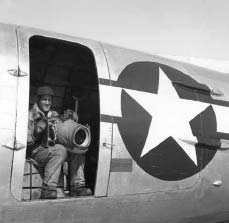
DENA 5438, Denali National Park and Preserve Museum Collection
After this expedition, Washburn continued to work with the U.S. Navy’s Chief of Naval Research, Rear Admiral T.A. Solberg, who was also interested in cosmic ray research. In 1949, Washburn announced to the press that Mount McKinley had “been proposed for the world’s highest permanent cosmic ray laboratory” (SMR August-September 1949, Drury 1950). Due to protests from conservationists, Washburn was asked to look elsewhere, and by mid-June 1950 he announced that “a location other than Denali has been agreed upon” for those purposes (Tomlinson 1950, Clark 1950, Washburn 1950).
Despite his earlier setback, Washburn persisted in suggesting Mount McKinley as a potential development site. In May 1951, Washburn told a University of Alaska audience that Denali and other high Alaska peaks were being mapped for use as radar stations, weather observation points and centers of nuclear research. Later that year, he told reporters in Anchorage and Fairbanks that the mountain would be a highly favorable site for “a fixed position radar station” or “a cosmic ray station for the advancement of atomic research.” This advocacy continued for years afterward (NYT 1951, ADT 1951, LAT 1951).
Washburn, though unsuccessful in establishing a research station on the mountain, did what he could to encourage cosmic ray research. In 1952, for example, he convinced a Mount McKinley climber, Army Capt. William Hackett, to conduct scientific research. Hackett agreed to carry “several nuclear plates coated with special emulsions to record the effect of cosmic rays striking the earth.” Whether the plates yielded much information, however, is unclear (Pearson 1962).
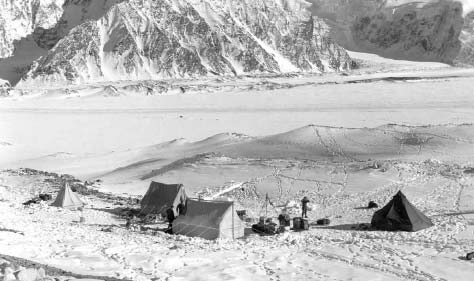
Operation White Tower Collection, Denali National Park Museum Collection
The last known proposal to utilize the upper slopes of Mount McKinley emerged during the late 1950s. After the Soviet Union launched the Sputnik 1 satellite in October 1957, U.S. authorities became far more aware of their defense vulnerabilities. In a plan to buttress America’s sagging defenses, Hughes Aircraft engineer Vernal Tyler proposed the construction of a long, vertical tunnel under Mount McKinley, the primary purpose of which would be to launch high altitude space missiles.
Implementing the plan, however, would require the construction of a 52-mile railroad spur, the construction of an 18-mile horizontal tunnel, and the drilling of two 10,000-foot-long vertical shafts under Mount McKinley. Tyler, so far as is known, made little or no headway with his scheme, but four years later, two other engineers aired much the same proposal – and had similar results (ADT 1959, ADT 1964).
Given the strong emphasis on science in many of the early climbs of Mount McKinley, it is not surprising that science played a role in shaping climbing policy. Until 1950, all climbing parties had approached the mountain from the north. But in 1951, a scientific expedition broke new ground when pilot Terris Moore dropped off an eight-man party (which included Bradford Washburn) at the 8,500-foot level of Kahiltna Glacier, and all eight summited the mountain from the southwest (Sfraga 2004, SMR June 1951, Pearson 1962, Washburn and Roberts 1991).
Several months later, in February 1952, the Harvard Mountaineering Club contacted the park and re-quested permission to allow supplies to be air-dropped at McGonagall Pass as part of a planned climb of Mount McKinley later that year (Maier 1952). The Harvard party’s air-drop request, which was needed “to test new Army equipment” and “to conduct survey operations and geological collecting,” stirred the NPS to review its climbing regulations.
A month later, Director Conrad Wirth issued a new policy that prohibited airdrops, but supported glacier landings in the park if they were connected to “a scientific party,” a policy that was reiterated in slightly revised form in mid-June 1952. This policy, new to Denali, was entirely unlike any policies that were in place at Mount Rainier, Grand Teton, or other national park units that attracted mountain climbers (Pearson 1952, Jackson 1999, Catton 1996).
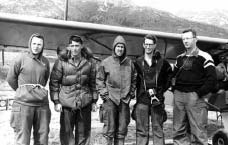
DENA 17-23, Denali National Park and Preserve Museum Collection
Wirth’s policy regarding a “scientific” need for glacier landings remained in place for years afterward. In the spring of 1954, for example, Superintendent Grant Pearson noted that a five-man climbing party had asked if it could land supplies on Straightaway Glacier, northwest of Mount McKinley. Pearson noted that the party “had permission for air support as they are making tests for the Ladd Field Aero Medical Laboratory and the UpJohn [Pharmaceutical] Company.” (Figure 7)
A year later, Pearson justified a climbing request because one member was a U.S. Weather Bureau employee, another was with the Bureau of Land Management, and the two planned to make scientific studies for their respective agencies (SMR May 1954, May 1955).
After the 1955 season, however, Superintendent Pearson began to have second thoughts about the park’s support for aircraft landings in conjunction with summit climbs.
Because NPS regulations allowed non-scientific parties to spend additional time and money on their summit attempts, “mountain climbers [were increasingly] resorting to subterfuge” by “attempting to... assume the position of being a scientific venture” in “an attempt to evade the issues set forth in our regulations.” Pearson, trying to respond to those demands, said that “one suggestion [which] may have some merit ... would be to allow one air drop of equipment and supplies per party at the base of the mountain.”
This “base” was defined as a “low elevation base camp such as at McGonagall Pass.” Pearson’s suggestion met with general approval, and on March 19, 1956, Wirth issued an aircraft policy statement that cancelled his earlier (June 1952) statement (Pearson 1955, Lee 1956, Coates 1962).
The new rule was widely approved and appeared to have the potential to fundamentally change the way in which climbers organized their expeditions. During the winter of 1956-57, however, a new event made the air-drop rule largely irrelevant.
The Muldrow Glacier (according to Grant Pearson) “made a sudden rapid downhill movement” that “was still heaving and shifting” in June 1957. This “galloping glacier” made the Muldrow useless for climbers (Pearson 1962, SMR May-July 1957). Beginning in 1958, therefore, the vast majority of Mount McKinley climbing parties used Kahiltna Glacier as their access point. Because most of these parties did not have scientific permits, Talkeetna pilot Don Sheldon and his as-sociates landed climbers just south of the park boundary (Greiner 1974, Pearson 1962, SMR 1958-60).
But beginning in 1962 or 1963, Sheldon and other pilots began using
the Kahiltna’s southeast fork, at or near the 7,000-foot level (and just inside the park boundary), a practice that became the norm in later years (Various correspondence).
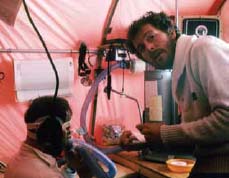
NPS Photo / Roger Robinson
Throughout this period, the NPS scientific requirements remained in place. As late as May 1960, author James Greiner noted that “All expeditions that are airlifted to points on the mountain within the geographical borders of Mt. McKinley National Park must be conducted under scientific permits issued by park authorities.”
Greiner also noted that a would-be climber that spring, John Day, had “secured authorization for a ‘photographic’ expedition, a marginal category only occasionally acknowledged by authorities.” (Greiner 1974). But given the move to Kahiltna Glacier, and the consequent lack of a need for airdrops, climbers no longer were required to cite scientific pursuits to justify a Mount McKinley ascent, and before long the clause that provided preferential treatment to scientific expeditions was removed from the park’s climbing regulations.
Since the 1960s, Mount McKinley has continued to attract scientists. Key contributions have been made by members of high-altitude medical research teams, who beginning in 1981 performed the dual role of scientifically measur-ing the effects of high altitudes (and high latitudes) on climbers’ physiological systems, and performing valuable medical assistance to those who have suffered from high-altitude pulmonary edema and related stressors (Figure 8).
These teams, which are organized through the University of Alaska Anchorage’s High Latitude Research Group, established a camp at Mount McKinley’s 14,200-foot level in 1984. Their assistance has been a key element of the park’s climbing management program ever since.
This article is based on Crown Jewel of the North: An Administrative History of Denali National Park and Preserve, by Frank Norris.
References
Anchorage Daily Times (ADT). July 14, 1951, 8.
Anchorage Daily Times (ADT). July 15, 1959, 16.
Anchorage Daily Times (ADT). January 15, 1964, 9.
Beiser, Germaine, and Arthur Beiser. 1962.
The Story of Cosmic Rays. E. P. Dutton. New York.
Brown, William E. 1991.
A History of the Denali-Mount McKinley Region.
National Park Service. Santa Fe.
Catton, Theodore. 1996.
Wonderland: An Administrative History of Mount Rainier National Park. National Park Service. Seattle.
Clark, Lewis F. 1950.
Memo to Urner Liddel, June 5, 1950. File 845 (“Research”), CCF, RG 79, NARA San Bruno.
Coates, Jerrol. 1962.
Memo to Dave Johnston, October 23, 1962, in Folder 67, Series 2, DMRC.
Drury, Newton. 1950.
Memo to Olaus J. Murie (attachment), January 9, 1950, in File 845 (“Research”), CCF, RG 79, NARA San Bruno.
Greiner, James. 1974.
Wager with the Wind: The Don Sheldon Story. Rand McNally. Chicago.
Jackson, Reynold G. 1999.
Park of the Matterhorns. In A Place Called Jackson Hole; A Historic Resource Study for Grand Teton National Park by John Daugherty. Grand Teton Natural History Association. Moose, WY.
Lee, Ronald F. 1956.
Memo to Region 4 Regional Director, March 21, 1956, in Folder 35, Series 2, DMRC.
Los Angeles Times (LAT). July 19, 1951, 22.
Maier, Herbert. 1952.
Letter to Supt. MOMC, February 7, 1952, in Folder 19, Series 2, DMRC.
New York Times (NYT). May 22, 1951, 2.
Pearson, Grant. 1952.
Letter to American Alpine Club, December 29, 1952, in Folder 19, Series 2, DMRC.
Pearson, Grant. 1955.
Memo to Regional Director, Region 4, December 13, 1955, in Folder 29, Series 2, DMRC.
Pearson, Grant. 1962.
My Life of High Adventure. Ballantine Books. New York.
Sfraga, Michael. 2004.
Bradford Washburn: A Life of Exploration. Oregon State University Press. Corvallis, OR.
Stuck, Hudson. 1914.
The Ascent of Denali, (Mount McKinley) a Narrative of the First Complete Ascent of the Highest Peak in North America. C. Scribner’s Sons. New York.
Superintendent’s Monthly Report (SMR). 1932, 1949, 1951, 1954, 1955, 1957. Mount McKinley National Park, Superintendent’s Monthly Report. National Park Service.
Tomlinson, O.A. 1950.
Memo to Murie, February 16, 1950. File 845 (“Research”), CCF, RG 79, NARA San Bruno.
Ullman, James Ramsey. 1945.
The White Tower. Lippincott. Philadelphia, PA.
Various correspondence in Folders 44, 49, 55, 60, 80, 82, 86, and 91; all in Series 2, DMRC.
Washburn, Bradford. 1950.
Memo to Lewis Clark, June 9, 1950. File 845 (“Research”), CCF, RG 79, NARA San Bruno.
Washburn, Bradford, and David Roberts. 1991.
Mount McKinley: the Conquest of Denali. Abrams. New York.
Part of a series of articles titled Alaska Park Science - Volume 10 Issue 2: Connections to Natural and Cultural Resource Studies in Alaska’s National Parks.
Last updated: February 3, 2025
